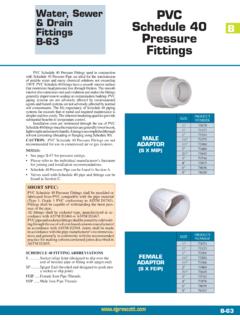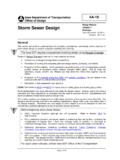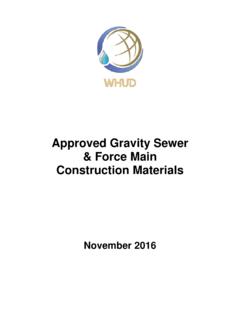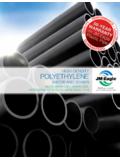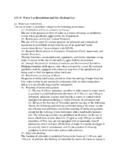Transcription of Packer Injection Grouting for the Long-Term - An ...
1 Reprinted with permission from Proceedings of Water Environment Federation Specialty Conference, May 18-21, 2008,Pittsburgh, Pennsylvania. Copyright 2008 Water Environment Federation, Alexandria, Virginia. Packer Injection Grouting for the Long-Term An Engineering Perspective Robert K. Lee, Malcolm Pirnie, Inc. 640 Freedom Business Center, Suite 310 King of Prussia, PA 19406 ABSTRACT Packing Injection Grouting , or also known as testing and sealing of pipe joints, has often been the victim of a poor reputation. A number of utility owners have had bad experiences in attempting to stop or impede the infiltration of clean water into their sewer lines by Grouting the pipe joints and laterals. The goal of any sewer rehabilitation is to ensure the proper longevity of the work. Failures that occur within months or even a couple of years after completion of the rehabilitation work are not an acceptable option.
2 Grouting , in theory, has been a cost-effective method of sealing pipe joints and can be a very viable technology for structurally-sound pipes. Grouting has been unsuccessfully attempted in the past by numerous municipalities. However, past failures of Grouting are generally attributable to technical issues, some of which are largely unknown by even the contractors who perform the Grouting work. Grouting failure is caused by a number of issues. One of the primary causes of failure is related to the control of the grout mixture rather than actual grout Injection procedure. One of the critical issues is gel time the time it takes for the grout to catalyze from liquid form to gelatinous form. Gel times are often set to ensure that the grout moves through the open pipe joint and into the surrounding soil before hardening, thus forming a soil-grout matrix around the pipe joint and sealing it from future groundwater infiltration.
3 However, gel times can vary dramatically with changes in temperature. For typical grout used in sewer pipe joint sealing, manufacturers state that gel times can be doubled (or halved) for every 10 F change in temperature. Operators, engineers, and inspectors who are unaware of this nuance may think that a pipe joint has been successfully sealed because it passes a subsequent air test, but in reality the surrounding soil has very little grout and the joint has been simply veneered . This cause of failure and others failures will be discussed in this paper. Some of the other topics will include: The critical details of the grout mixture and Grouting techniques Highlighting the types of grout available for sewer pipe joint sealing Specifying the correct gel time based on pipe size, pumping rates, and project goals Methods to ensure gel times meet the contract documents Discussing the additives that can be used to increase grout strength and performance in sewer pipe joint sealing applications Using step- Grouting as a technique to pack large voids or soils Recommended contract requirements to help ensure successful Grouting jobs.
4 Importance of observing the work by a qualified Resident Project Representative Copyright 2008 Water Environment Federation. All Rights ReservedCollection Systems 2008366 Reprinted with permission from Proceedings of Water Environment Federation Specialty Conference, May 18-21, 2008,Pittsburgh, Pennsylvania. Copyright 2008 Water Environment Federation, Alexandria, Virginia. KEYWORDS Sanitary Sewers, Infiltration, Inflow, Grouting , Sewer Rehabilitation, Infiltration, Pipe Joint Testing and Sealing INTRODUCTION Chemical grouts have been in use for over 50 years. For sewer systems, the intent of chemical Grouting in sewer systems is to seal leaks and stop infiltration and exfiltration. Most leaks in structurally sound sewer systems are through pipe joints, manholes, service connections, and service laterals. Grouting does not simply fill existing defects and open pipe joints; grout is pumped under pressure through the defects and joints and into the surround soil/pipe bedding where they gel with the soil and for a gel-soil matrix that provides a waterstop around the pipe defect or joint.
5 In addition, this gel-soil matrix can provide the added benefit of stabilizing the soil, preventing further loss of pipe bedding into the pipe, and providing longer-lasting support. Figure 1 Grout-Soil Ring The basic principle of Grouting pipe lines is to test the joints by hydraulically applying a positive pressure to the joints, monitoring the pressure in the void and monitoring the test medium flow rate. The test medium is usually air. The intent of joint testing is to identify those sewer pipe joints that are not watertight and that can be successfully sealed by Packer Injection Grouting . Packer Injection Grouting shall be accomplished by pressure Injection of chemical grout into the soils encompassing the pipe joint. Chemical grouts are designed to be injected into the soil surrounding the pipe. Catalyzation is supposed take place at the point of Injection /repair. Adequate volumes of grout must be injected to form an effective watertight seal.
6 Grouting BASICS Grouting is simple, quick and relatively inexpensive compared to other rehabilitation technologies. Its main limitation is that it cannot repair broken pipes, as pipe lining and pipe busting can. It is highly effective, however, on sound pipes that are admitting groundwater through the joints. When a utility has identified leaking but otherwise generally structurally sound sewer pipes and manholes, Grouting is a feasible option. Copyright 2008 Water Environment Federation. All Rights ReservedCollection Systems 2008367 Reprinted with permission from Proceedings of Water Environment Federation Specialty Conference, May 18-21, 2008,Pittsburgh, Pennsylvania. Copyright 2008 Water Environment Federation, Alexandria, Virginia. Sewer mainline packers are cylindrical devices which can be accurately positioned over joints or circular cracks by means of cables attached to either access point of the sewer ( , manholes).
7 The packers have inflatable ends that expand tightly against the pipe walls, isolating a short section of pipe and creating a void into which a test medium can be pumped. A sensing unit is normally located within the void area and will accurately transmit continuous pressure readout to the control panel. If pressure drops indicate the joint does not pass, grout can be delivered into the void area and into the joint/defect. Figure 2 Typical Sewer Main Packer Equipment (Logiball, Inc., Used by Permission) Figure 3 Typical Sewer Main Packer Equipment Setup (Logiball, Inc., Used by Permission) Copyright 2008 Water Environment Federation. All Rights ReservedCollection Systems 2008368 Reprinted with permission from Proceedings of Water Environment Federation Specialty Conference, May 18-21, 2008,Pittsburgh, Pennsylvania. Copyright 2008 Water Environment Federation, Alexandria, Virginia. Tap and lateral service sealing is generally accomplished with a lateral Packer .
8 The objective of the lateral service Packer is to seal the tap connection to the main sewer and a portion of the lateral service. Commonly used lateral Packer systems are positioned in a main line so that the center section of the Packer aligns with the lateral line. Then an inflatable tube is inserted into the lateral line (generally between 6 feet up to 30 feet). The free end of this tube is larger than the rest so it will press out against the lateral pipe and form a tight plug. When the two ends of the Packer are inflated in the main line a T-shaped area, including part of the main and the lateral line, is effectively isolated from the rest of the sewer system and can be tested with air pressure. If a leak is found, chemical grout can be applied to seal it. After the grout has been applied, the connection is tested again. Figure 4 Typical Lateral Grouting Sealing of lateral pipe joints for laterals connected to manholes can either be done using by either pushing smaller mainline packers or by the use of a push Packer .
9 A push Packer operates in the same manner as a mainline Packer except access is only required at one end. The push Packer is physically placed and the pipe section between the inflatable ends is usually much longer than a mainline Packer . Figure 5 Example of Push Packer Copyright 2008 Water Environment Federation. All Rights ReservedCollection Systems 2008369 Reprinted with permission from Proceedings of Water Environment Federation Specialty Conference, May 18-21, 2008,Pittsburgh, Pennsylvania. Copyright 2008 Water Environment Federation, Alexandria, Virginia. Grout materials are pumped into the void space and into the joints and potentially other defects through the hose system at controlled pressures that are in excess of groundwater pressures. The pumps should be run continuously until refusal. Refusal means that the mixed grout has flowed through any joint failure, through other defects, through any annular space, and into the surrounding soil; gelled or filled the available void space; and formed a cohesive seal stopping further grout flow, until an appropriate back pressure is achieved while pumping (per the specifications or per the ASTM standards).
10 DESIGN LIFE OF GROUT One of the key questions in Grouting revolves around the design life of grout. Excavation activities have revealed that Grouting performed 25 to 30 years ago still maintain the soil-gel matrix ring around the pipe joints. However, grout is subject to drying and cracking so it is important that grout constantly stays wet or humid. For sewers that are below the water table year round, Grouting may have a longer design than sewers that are only seasonally below the ground water table. Most agree that Grouting won t last as long as a newly installed pipe. In order to perform equal life-cycle costs, many engineers and utilities have generally settled on a 10- to 15-year life cycle for Grouting . However, at less than a one-sixth of the cost of replacement and one-fourth of the cost of cured-in-place pipe lining, this approach is easy more cost-effective, quickly reduces I&I flows, and stabilizes the structural condition of the pipeline.
